CIRCULAR MOTION for Class 11 PHYSICS
INTRODUCTION
Circular motion hai kya? Suppose fan ke blade pr ek particle stuck hai aur fan chal raha hai to wo particle bhi circular motion me move krega. Circular motion me sabhi time pr us particle ki speed constant hogi (agr regulator ko na rotate kiya jae). Pr kya har ek point pr velocity constant hogi? Isse samajhne ke liye hum speed aur velocity ke bich ka difference samjhenge. Speed vector quantity nahi hai (has only magnitude) lekin velocity vector quantity hai (has both magnitude and direction).
Jab fan constant speed se chalta hai to har ek point pr velocity ka direction change hota hai. Ager direction change nahi hoga to wo turn nahi lega aur particle straight chala jaega.
Jab koi object circular path me move karta ho ek constant speed me to us object ke motion ko uniform circular motion kahte hai.
In our everyday life, we came across many examples of circular motion for example cars going round the circular track and many more. Also earth and other planets revolve around the sun in roughly circular orbits.
The motion of a body is said to be circular if it moves in such a way that its distance from a certain fixed point always remains the same.

Circular motion uniform ya non-uniform ho sakta hai. Uniform circular motion me, rotation aur speed ka angular rate constant hota hai aur non-uniform motion me, rotation ka rate change hote rehta hai. Isliye, non-uniform acceleration ke liye, angular acceleration zero nahi hota hai.
UNIFORM CIRCULAR MOTION
Jab koi body circular path me constant speed se move krta hai to usse uniform circular motion kehte hai. Particle ka speed constant hoga pr velocity constant nahi hoga. Velocity vector quantity hai aur speed aur direction dono pr depend krta hai. Velocity change ho raha hai matlab acceleration hoga. Isse centripetal acceleration kehte hai. Iska magnitude constant hoga aur ye hmesha axis of rotation ke towards direct krega. Ye acceleration centripetal force produce krta hai. 
Formula for Uniform Circular Motion:
Tangential speed =2πrt
Centripetal acceleration, a=v2r
Centripetal acceleration
Hum ek particle consider krte hai jo constant speed se circular path me move krta hai. Hum ab normal component of acceleration, particle ke speed aur radius of path ke bich relationship derive krna discuss krenge.To understand this consider the figure given below
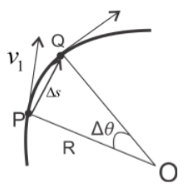
Figure ek particle represent krta hai jo circular path me move kr raha hai, uaka radius R aur uska centre O pr hai. Yaha vectors v1 point P pr aur v2 point Q pr velocities represent krta hai. Niche diye figure me aap dekhenge vector change in velocity (Δv) jab particle time (Δt) me point P se Q move krta hai.
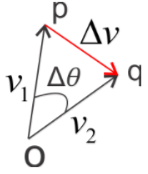
1st figure me triangle OPQ aur 2nd figure me triangle opq dono similar hai kyunki dono hi isosceles triangle hai aur dono triangles me Δθ angles bhi same hai. Hence we have Δvv1=ΔsR
or Δv=v1RΔs
|α⊥| time Δt me average normal acceleration ka magnitude hai aur ye ΔvΔt ke equal hai. So from above equation we get
|α⊥|=ΔvΔt=v1RΔsΔt
So the instantaneous acceleration a⊥ at point P is the limiting value of this expression as we take point Q to point P and Δt→0
So, a⊥=limΔt→0v1RΔsΔt=v1RlimΔt→0(ΔsΔt)
But the limiting value of ΔsΔt is the speed v1 of the particle at point P. Since P can be any point in the path , we can conveniently drop the subscript from v1 and let v represent the speed of the particle at any point in the circular path. So
a⊥=v2R
So, from the above equation we can say that
The magnitude of the instantaneous normal acceleration is equal to the square of the speed divided by the radius. Its direction is perpendicular to v and acts along inward along the radius of the circular path towards the center of the circle.
Isliye isse central ya centripetal acceleration kehte hai. Centripetal ka matlab hota hai ‘seeking the center’. Ab tak humne discuss kiya hai circular motion physics with particles moving with constant speed. If the speed varies then above equation for normal acceleration or centripetal acceleration still holds but in case of varying speed you also have a tangential component of acceleration a∥, equal of the rate of change of speed. So,
a∥=limΔt→0(Δv∥Δt)
So if the speed is constant then there is no tangential acceleration. In this case acceleration is purely normal . This normal acceleration is the result of the continuous change in direction of the velocity.
Angular velocity
Consider an object moving in a circle with uniform velocity v as shown below in the figure.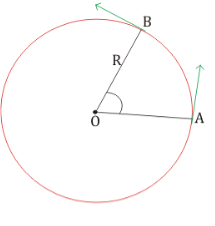
The velocity v at any point of the motion is tangential to the circle at that point.Let the particle moves from point A to point Belong the circumference of the circle .The distance along the circumference from A to B is
s=Rθ ..........(i)
Where R is the radius of the circle and θ is the angle moved in radians
Magnitude of velocity is
v=dsdt=Rdθdt ............(ii)
Since radius of the circle remains constant quantity,
ω=dθdt ..........(iii)
is called the angular velocity defined as the rate of change of angle swept by radius with time.
Angular velocity is expressed in radians per second (rads−1)
From equation (ii) and (iii),we find the following
v=ωR ............(iv)
Thus for a particle moving in circular motion ,velocity is directly proportional to radius for a given angular velocity.
For uniform circular motion i.e, for motion with constant angular velocity the motion would be periodic which means particle passes through each point of circle at equal intervals of time
Time period of motion is given by
T=2πω ...........(v)
Since 2π radians is the angle θ in one revolution
If angular velocity ω is constant then integrating equation (iii) within limits θ0 to θ,we find
∫θθ0dθ=∫tt0ωdt=ω∫tt0dt
or,
θ=θ0+ω(t−t0) …………(vi)
where θ0 is the angular position at time t0 and θ is the angular position at time t .The above equation is similar to rectilinear motion result x−x0=v(t−t0)
Angular acceleration
Angular acceleration is defined as the rate of change of angular velocity moving in circular motion with time.Thus
α=dωdt=d2θdt2 ............(vii)
Unit of angular acceleration is rads−2
For motion with constant angular acceleration
∫θθ0dθ=∫tt0ωdt=∫tt0ω0dt+α∫tt0(t−t0)dt
or,
ω=ω0+α(t−t0) ...........(viii)
where ω0 is the angular velocity at time t0
Again since
ω=dθdt
or dθ=ωdt then from equation (viii)
On integrating we get
θ=θ0+ω(t−t0)+12α(t−t0)2 ………….(ix)
If in the beginning t0=0andθ0=0 the angular position at any time t is given by θ=ωt+(12)αt2
This result is of the form similar to what we find in case of uniformly accelerated motion while studying rectilinear motion.
Linear acceleration is the rate of change of velocity without a change in direction; e.g., when the speed of an aircraft increases while flying a straight pathway.
Relation between linear acceleration and angular acceleration:
v=ω⇒dvdt⇒(dωdt)r⇒al=ar
This acceleration is along tangent, so it is called tangential acceleration.

Equations of Motion for Uniform Circular Motion
Ek particle jo circular motion perform kr raha hai, usse uske position vector →r(t) se describe kr sakte hai. Figure me aap dekhenge ek particle counterclockwise direction me circular motion perform kr raha hai.
As the particle moves on the circle, its position vector sweeps out the angle θ with the x-axis. →r(t) making an angle θ with the x-axis is shown with its components along the x– and y-axes. The magnitude of the position vector is A=|→r(t)| and is also the radius of the circle, so that in terms of its components,→r(t)=Acosωtˆi+Asinωtˆj.
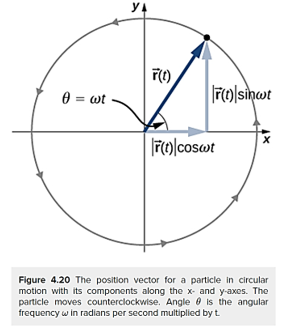
Yaha ω constant hai aur isse particle ka angular frequency kehte hai. The angular frequency has units of radians (rad) per second and is simply the number of radians of angular measure through which the particle passes per second.
The angle θ that the position vector has at any particular time is ωt.
Ager T period of motion hai ya ek revolution complete krne ka time (2πrad) hai, to ω=2πT.
Velocity and acceleration can be obtained from the position function by differentiation:→v(t)=d→r(t)dt=−Aωsinωtˆi+Aωcosωtˆj.
Figure me aap dekhenge velocity vector particle ke location pr circle ke tangential hai aur uska magnitude Aω hai.
Similarly, the acceleration vector is found by differentiating the velocity:→a(t)=d→v(t)dt=−Aω2cosωtˆi−Aω2sinωtˆj.
Is equation se aap dekhenge acceleration vector ka magnitude Aω2 hai aur wo position vector ke opoosite me directed hai, toward the origin, kyunki →a(t)=−ω2→r(t).
Problem solving strategy
Creating an Acceleration of 1 gA jet is flying at 134.1m/s along a straight line and makes a turn along a circular path level with the ground. What does the radius of the circle have to be to produce a centripetal acceleration of 1g on the pilot and jet toward the center of the circular trajectory?
Strategy
Given the speed of the jet, we can solve for the radius of the circle in the expression for the centripetal acceleration.
Solution
Set the centripetal acceleration equal to the acceleration of gravity: 9.8m/s2=v2/r.
Solving for the radius, we find r=(134.1m/s)29.8m/s2=1835m=1.835km.
Significance
To create a greater acceleration than g on the pilot, the jet would either have to decrease the radius of its circular trajectory or increase its speed on its existing trajectory or both.
NON-UNIFORM CIRCULAR MOTION
Non-uniform circular motion me jo particle circular path me move kr raha hai uske speed me change hota hai. Velocity ke vector size me especially change hota hai jo ye batata hai ki velocity ke magnitude me change hua hai.
Non-Uniform circular motion me:
1. Object ka velocity vector hmesha circle ke tangent hoga.
2. Object ka speed aur angular speed constant nahi hoga.
3. Object ka angular acceleration zero nahi hoga.
4. Acceleration vector center of the circle ke towards point nahi krega.
Non-uniform circular motion me, net acceleration (a) Δv ke direction ke along hota hai jo circle ke ander direct krta hai pr centre se pass nahi hota. Net acceleration ko do components me resolve kr sakte hai: tangential acceleration aur normal acceleration jisse centripetal or radial acceleration bhi kehte hai. Centripetal acceleration dono uniform aur non-uniform circular motion me present hota hai.
Jab acceleration vector circle ke centre ke towards point nahi krega to usse do components me break kr sakte hai, aR aur aT. Component aR circle ke centre ke towards hoga (radial) aur component aT circle ke tangent hoga aur radial component ke perpendicular hoga. Radial component velocity ke direction ke change me responsible hota hai.
aR=v2r
aT=dvdt
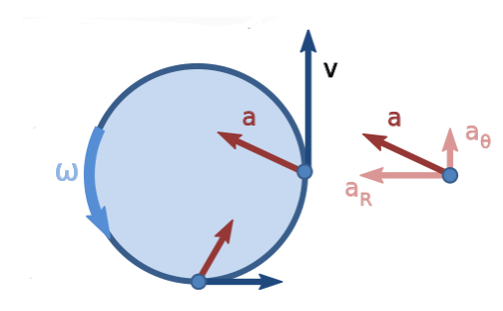
Let us use the vector method to discuss non-uniform circular motion.
Niche diye figure me, ˆer unit vectors along radius hai aur ˆeθ tangent vector hai. er aur eθ ke terms me, particle ka motion jo circle me clockwise move kr raha hai usse vector equation se describe kr sakte hai.
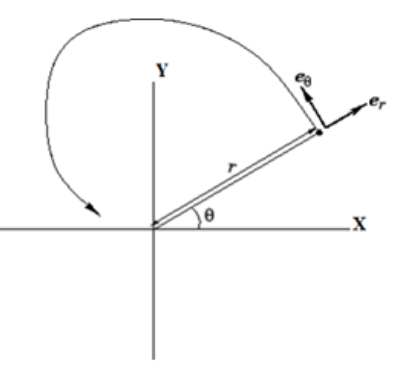
→v=ˆeθv
Is case me, sirf ˆeθ hi nahi balki v bhi time ke saath vary krta hai. Hum instantaneous acceleration obtain kr sakte hai,
→a=d→vdt=ˆeθ(dθdt)+v(dˆeθdt)
→a=d→vdt=ˆeθdθdt+v(dˆeθdt)
Again,
dˆeθdt=ˆerv2r
→a=ˆeθaT−ˆer(v2r)=aTˆeθ−aRˆer
Here, aT=dvdt and aR=v2r
First term, ˆeθaT →A ka vector component hai aur aR centripetal acceleration hai.
The magnitude of →Ais|→a|=√a2T+a2N
OMR (One Minute Revision)
- * When an object moves in a circle, it’s velocity is tangent to that circle.
* The force towards the middle constantly changes the direction of the velocity. Without that force the object would keep moving in a straight line instead.
* In non- uniform circular motion, the size of the velocity vector (speed) changes, denoting change in the magnitude of velocity.
* The change in speed has implications for radial ( centripetal ) acceleration. There are two possibilities:
1. the radius of the circle is constant; or
2. the radial (centripetal) force is constant.
* In either case, the angular velocity in non-uniform circular motion is not constant, as ω=vr, and v varies.
Problem Solving Strategy
Total Acceleration during Circular Motion
A particle moves in a circle of radius r=2.0m. During the time interval from t=1.5s to t=4.0s its speed varies with time according to v(t)=c1−(c2t2),c1=4.0m/s,c2=6.0m⋅s.
What is the total acceleration of the particle at t=2.0s?
Strategy
We are given the speed of the particle and the radius of the circle, so we can calculate centripetal acceleration easily. The direction of the centripetal acceleration is toward the center of the circle. We find the magnitude of the tangential acceleration by taking the derivative with respect to time of
|v(t)| using and evaluating it at t=2.0s. We use this and the magnitude of the centripetal acceleration to find the total acceleration.
Solution
Centripetal acceleration is v(2.0s)=(4.0−6.0(2.0)2)m/s=2.5m/s
aC=v2r=2.5m/s22.0m=3.1m/s2 directed toward the center of the circle.
Tangential acceleration is aT=∣∣∣d→vdt∣∣∣=2c2t3=12.0(2.0)3m/s2=1.5m/s2.
Total acceleration is |→a|=√(3.12)2+(1.52)2m/s2=3.44m/s2 and θ=tan−13.11.5=64° from the tangent to the circle.
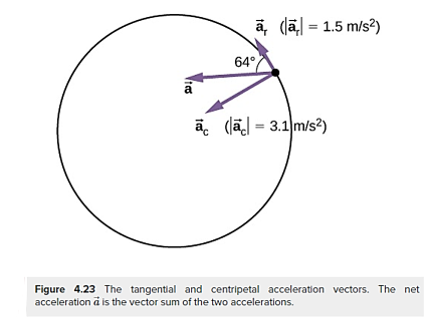
Significance
The directions of centripetal and tangential accelerations can be described more conveniently in terms of a polar coordinate system, with unit vectors in the radial and tangential directions.
POINT
Circular motion Circular motion is described as a movement of an object while rotating along a circular path.
Uniform circular motion Uniform circular motion is a specific type of motion in which an object travels in a circle with a constant speed.
Non uniform circular motion When a motion of an object denotes changes in the speed of the particle moving along the circular path, it is called non-uniform circular motion.
Radial: Moving along a radius.
Centripetal: Directed or moving towards a center.
Angular Velocity:Angular velocity is the time rate at which an object rotates, or revolves, about an axis, or at which the angular displacement between two bodies changes. Denoted by ω.
Angular speed Angular speed is the measure of how fast the central angle of a rotating body changes with respect to time. Denoted by ω.
Angular frequency,ω:
Rate of change of an angle with which an object that is moving on a circular path.
Centripetal acceleration
Component of acceleration of an object moving in a circle that is directed radially inward toward the center of the circle.
Tangential acceleration
Magnitude of which is the time rate of change of speed. Its direction is tangent to the circle.
Total acceleration:
Vector sum of centripetal and tangential accelerations.
EXAMPLE 1
A cyclist starts from the center O of a circular park of radius 1km, reaches the edge P of the park, then cycles along the PQ circumference and returns to the center along OQ as shown in fig. If the round trip taken ten minute, the (a) net displacement, (b) average velocity and (c) average speed of the cyclists (in kilometer and kinetic per hour) is
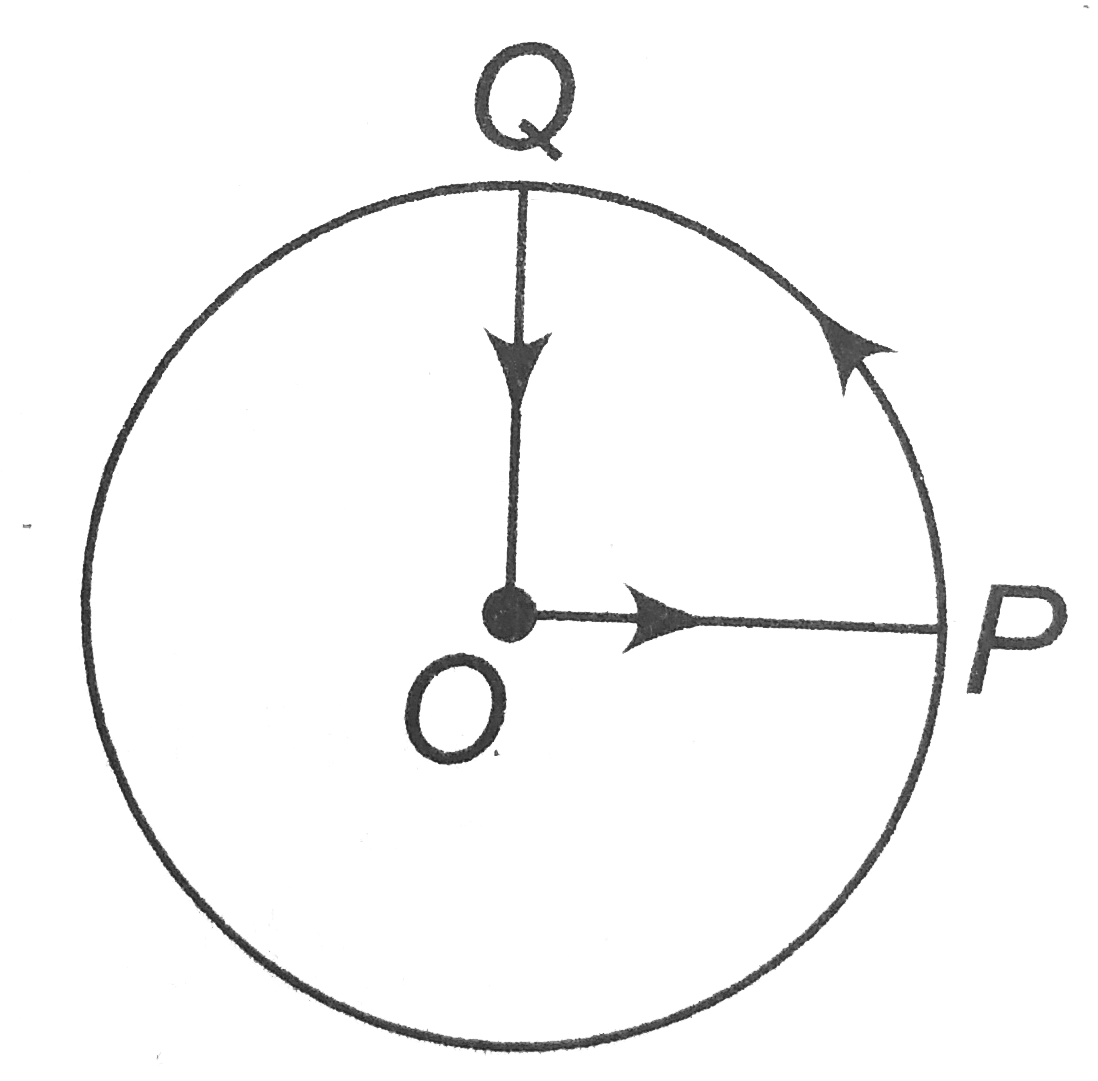
a) Since both the initial and final positions are the same therefore the net displacement is zero.
b) Average velocity is the ratio of net displacement and total time taken. Since the net displacement is zero therefore the average velocity is also zero.
c) Average speed = distance coveredtime taken
=(OP+Actual distance PQ + OQ)/(10minutes)
1km+14×2π×1km+1km10/60h
6(2+2214)kmh−1 = 6×5014kmh−1
=21.43kmh−1
EXAMPLE 2
A particle moves on a circular path of radius 8 m. distance traveled by the particle in time t is given by the equation s=23t3. Find its speed when tangential and normal accelerations have equal magnitude.
The speed v, tangential acceleration aτ and the normal acceleration an are expressed bu the following equations.
v=dsdt
Substituting the given expression for s, we have v=2t2
aτ=d2sdt2 …(i)
Substituting the given expression for s, we have aτ=4t
an=v2r ...(ii)
Substituting v from eq. (i) and r=8m, we have an=12t4 ...(iii)
The instant when the tangential and the normal accelerations have equal magnitude, can be obtained by equating their expressions given in eq. (ii) and (iii).
an=aT→ t=2s
Substituting the above value of t in eq. (i), we obtain v=8m/s
EXAMPLE 3
A cyclist is riding with a speed of 27kmh−1. As he approaches a circular turn on the road of radius 80 m, he applies brakes and reduces his speed at the constant rate 0.5ms−1. What is the magnitude and direction of the net acceleration of the cyclist on the circular turn ?
Here v=27km/h=27×518m/s=7.5m/s,r=80m
and tangential acceleration at=−0.50m/s2.
∴ Centripetal acceleration ac=v2r=(7.5)280=0.70ms−2 (radially inwards).
Thus, as shown in fig. above, two acceleration are acting in mutually perpendicular directions. If →a be the resultant accelerations, then
|→a|=√a21+a2c=√(0.5)2+(0.7)2=0.86ms−2
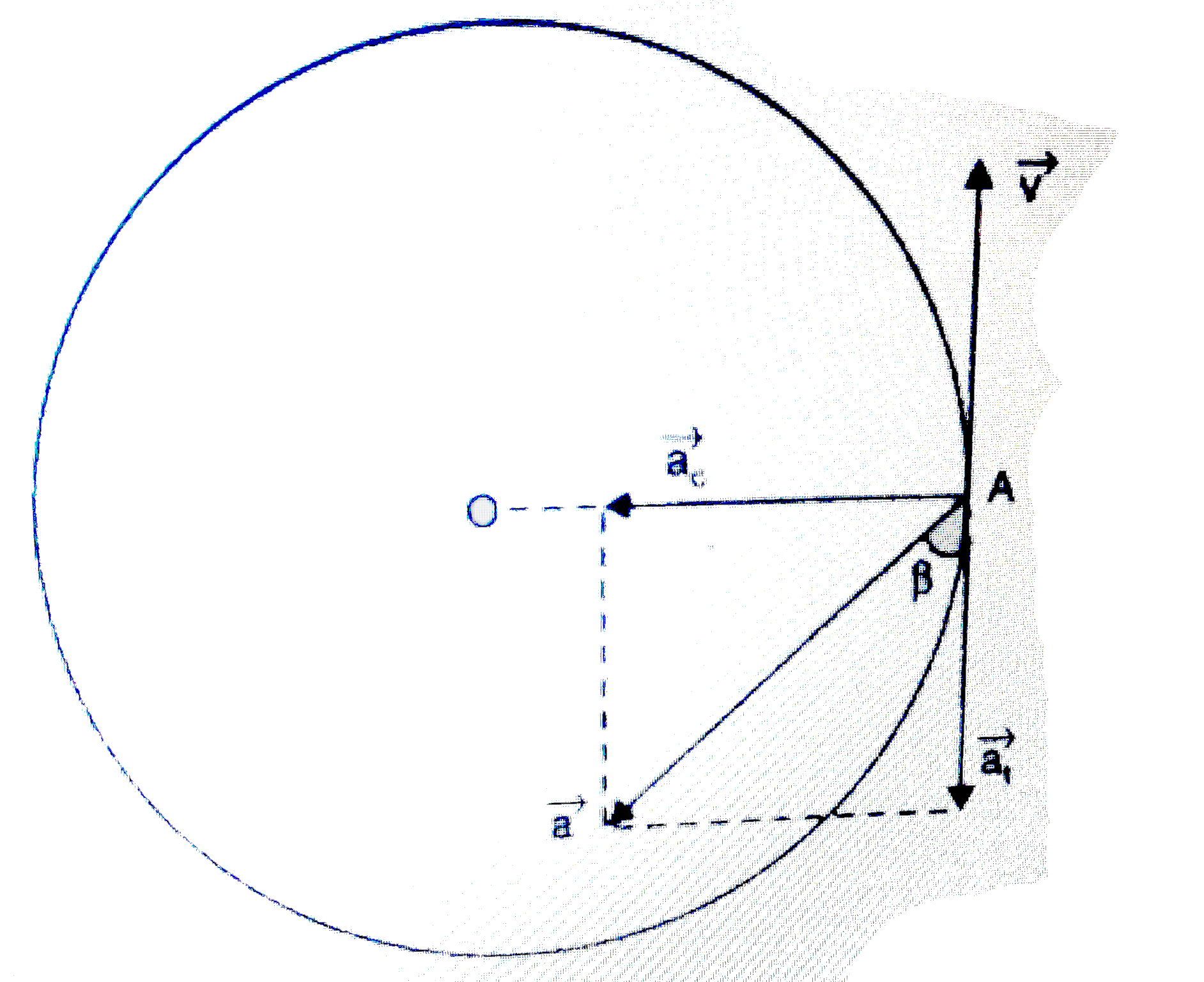
and tanβ=acat=0.70.5=1.4
⇒β=tan−1(1.$=54.5∘ from the direction of negative of the velocity.
EXAMPLE 4
(a) Earth can be thought of as a sphere of radius 6400 km. Any object (or a person) is performing circular motion around the axis of the earth due to the earth rotation (period 1 day ). What is acceleration of object on the surface of the earth (at equator) towards its centre ? What is it at latitude θ ? How does these accelerations compare with g=9.8m/s2?
(b) Earth also moves in circular orbit around the sun once every year with an orbital radius of 1.5×1011m. What is the acceleration of the earth (or any object on the surface of the earth) towards the centre of the sun? How does this acceleration compare with g=9.8m/s2 ?
(a) Radius of the earth (R)=6400km=6.4×106m
Time period (T) = 1 day =24×60×60s=86400s
Centripetal acceleration (ac)=ω2=R=R(2πT)2=4π2RT
=4×(22/7)2×6.4×106(24×60×60)2
=4×484×64×10649×(24×3600)2
=0.034m/s2
At equator, latitude θ=0∘
∴ acg=0.0349.8=1288
(b) Orbital radius of the earth around the sun (R) =1.5×1011m
Time period =1 Yr =365 day
=365×24×60×60s=3.15×107s
Centripetal acceleration (ac)=Rω2=4π2RT2
=4×(22/7)2×1.5×1011(3.15×107)2
=5.97×10−3m/s2
∴ acg=5.97×10−39.8=11641
EXAMPLE 5
A particle moves in a circle of radius 20 cm with linear speed of 10 m/s. Find the angular velocity.
The angular velocity is
ω= v / r = (10m/s)/(20cm)=50 rad/s.
EXAMPLE 6
Find the magnitude of the linear acceleration of a particle moving in a circle of radius 10 cm with uniform speed completing the circle in 4s.
The distance covered in completing the circle is 2πr=2π×10cm. The linear speed is
v=2πrt
=2π×10cm4s=5πcms.
The linear acceleration is
=v2r=(5πcms)210cm=2.5π2cms2
This acceleration is directed towards the centre of the circle.
EXAMPLE 7
Angular position θ of a particle moving on a curvilinear path varies according to the equation θ=t3−3t2+4t−2, where θ is in radians and time t is in seconds. What is its average angular acceleration in the time interval t=2s to t=4s?
Like average linear acceleration, the average angular acceleration αav equals to ratio of change in angular velocity Δω to the concerned time interval Δt.
αav=ΔωΔt=ωfinal−ωinitialtfinal−tinitial ...(i)
The angular velocity ω being rate of charge in angular position can be obtained by equation
ω=dθdt
Substituting the given expression of the angular position θ, we have
ω=3t2−6t+4 ...(ii)
From the above eq. (ii), angular velocities omeha2 and ω4 at the given instants t=2s and 4s are
ω4=4rad/s and ω4=28rad/s
Substituting the above values in eq. (1), we have αav=12rad/s2
EXAMPLE 8
A particle is moving in a circular orbit when a constant tangential acceleration. After 2s from the beginning of motion, angle between the total acceleration vector and the radius E becomes 45∘. What is the angular acceleration of the particle?
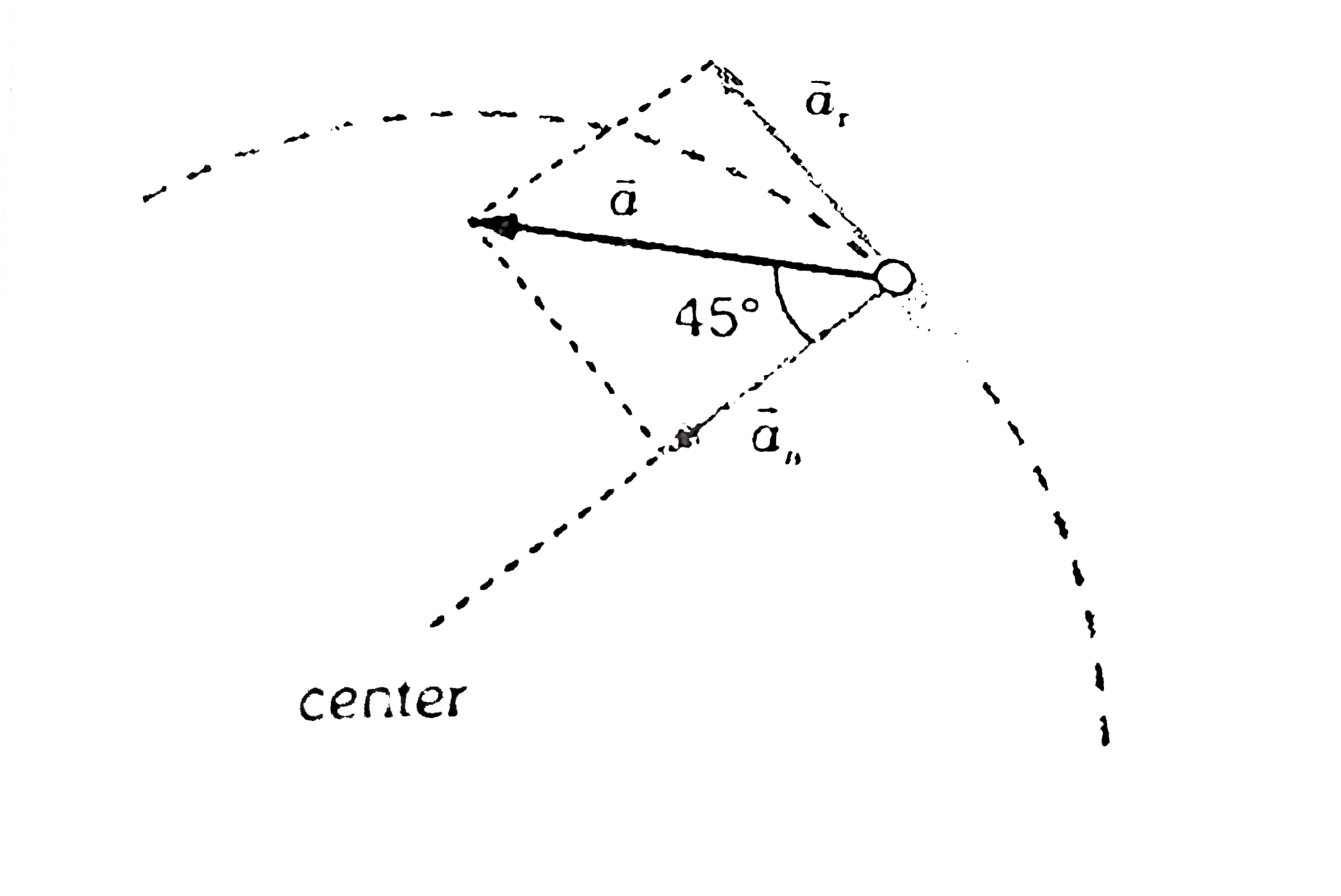
In the adjoining figure are shown the total acceleration vector →a and its components the tangential accelerations →aτ and normal acceleration →an are shown. These two components are always mutually perpendicular to each other and act along the tangent to the circle and radius respectively. Therefore, if the total acceleration vector makes an angle of 45∘ with the radius, both the tangential and the normal components must be equal in magnitudr.
Now from equation and, we have
aτ=an→αR=ω2R⇒α=ω2 ...(i)
Since angular acceleration is uniform, form equation, we have ω=ωo+αt
Substituting ω0=0 and t=2s, we have ω=2α ...(ii)
From equation (i) and (ii), we have α=0.25rad/s2
EXAMPLE 9
An insect trapped in a circular groove of radius 12cm moves along the groove steadily and completes 7 revolutions in 100s. (a) What is the angular speed, and the linear speed of the motion? (b) Is the acceleration vector a constant vector ? What is its magnitude ?
This is an example of uniform circular motion. Here R=12cm. The angular speed ω is given by
ω=2πT=2π×7100=0.44rad/s
The linear speed v is :
v=ωR=0.44s−1×12cm=5.3cms−1
The direction of velocity v is along the tangent to the circle at every point. The acceleration is directed towards the centre of the circle. Since this direction changes continuously, acceleration here is not a constant vector. However, the magnitude of acceleration is constant:
a=ω2R=(0.44s–1)2(12cm)
=2.3cms−2
SUMMARY
1. Uniform circular motion is motion in a circle at constant speed.
2. Centripetal acceleration →aC is the acceleration a particle must have to follow a circular path. Centripetal acceleration always points toward the center of rotation and has magnitude aC=v2r.
3. Non uniform circular motion occurs when there is tangential acceleration of an object executing circular motion such that the speed of the object is changing. This acceleration is called tangential acceleration →aT.
4. The magnitude of tangential acceleration is the time rate of change of the magnitude of the velocity. The tangential acceleration vector is tangential to the circle, whereas the centripetal acceleration vector points radially inward toward the center of the circle. The total acceleration is the vector sum of tangential and centripetal accelerations.
5. An object executing uniform circular motion can be described with equations of motion. The position vector of the object is →r(t)=Acosωtˆi+Asinωtˆj, where A is the magnitude |→r(t)|, which is also the radius of the circle, and ω is the angular frequency.